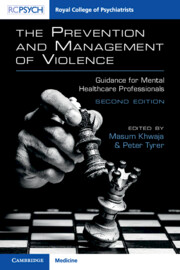Book contents
- The Prevention and Management of Violence
- The Prevention and Management of Violence
- Copyright page
- Dedication
- Contents
- Contributors
- Preface
- Abbreviations
- Section 1 General Aspects of Management
- Section 2 Medical and Psychological Intervention
- Section 3 Violence in Different Settings
- Introduction to Section 3
- Chapter 9 Management of the Risk of Violence in the Community
- Chapter 10 Management of Violence in Acute Medical Hospital Settings
- Chapter 11 Forensic Psychiatry and Adult Inpatient Secure Settings
- Chapter 12 Management of Violence in Prisons
- Section 4 Management in Other Groups
- Section 5 Violence and Society
- Section 6 Engagement and Understanding
- Index
- References
Chapter 10 - Management of Violence in Acute Medical Hospital Settings
from Section 3 - Violence in Different Settings
Published online by Cambridge University Press: 09 May 2023
- The Prevention and Management of Violence
- The Prevention and Management of Violence
- Copyright page
- Dedication
- Contents
- Contributors
- Preface
- Abbreviations
- Section 1 General Aspects of Management
- Section 2 Medical and Psychological Intervention
- Section 3 Violence in Different Settings
- Introduction to Section 3
- Chapter 9 Management of the Risk of Violence in the Community
- Chapter 10 Management of Violence in Acute Medical Hospital Settings
- Chapter 11 Forensic Psychiatry and Adult Inpatient Secure Settings
- Chapter 12 Management of Violence in Prisons
- Section 4 Management in Other Groups
- Section 5 Violence and Society
- Section 6 Engagement and Understanding
- Index
- References
Summary
Violence in the acute hospital sector is a common occurrence; however, it is often poorly understood and managed when compared to violence in other healthcare or institutional settings. Aetiological factors, the victim profile and perpetrator profiles vary when compared to other settings. There are particular challenges when considering risk assessment and how violence is managed in these settings. We explore these challenges in the context of staffing, training, environmental factors and the medical model of care. The milieu of an emergency department with high-turnover acute healthcare delivery and the impact this has on violence and its management are also explored. We aim to describe the extent of the problem and provide recommendations specific to the challenges faced in the acute hospital setting, with learning being applied from outside sectors. The topical subject of acute behavioural disturbance/excited delirium is also discussed.
Keywords
- Type
- Chapter
- Information
- The Prevention and Management of ViolenceGuidance for Mental Healthcare Professionals, pp. 155 - 165Publisher: Cambridge University PressPrint publication year: 2023



